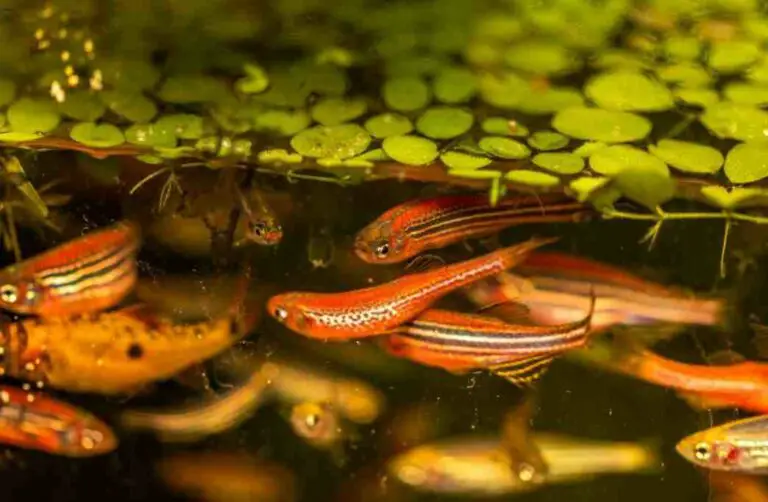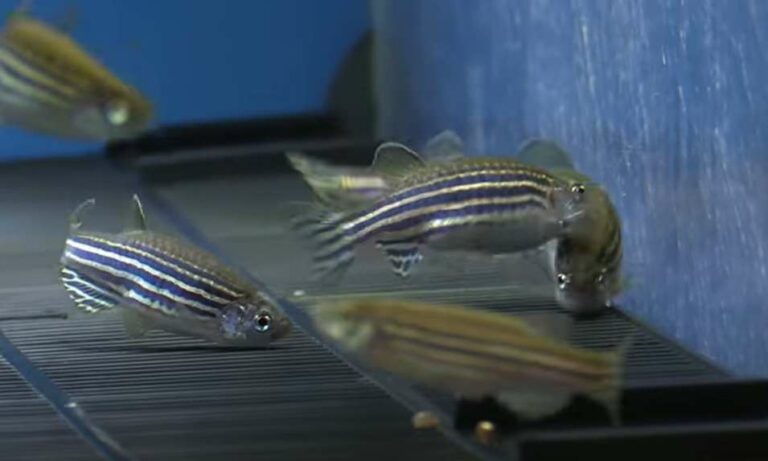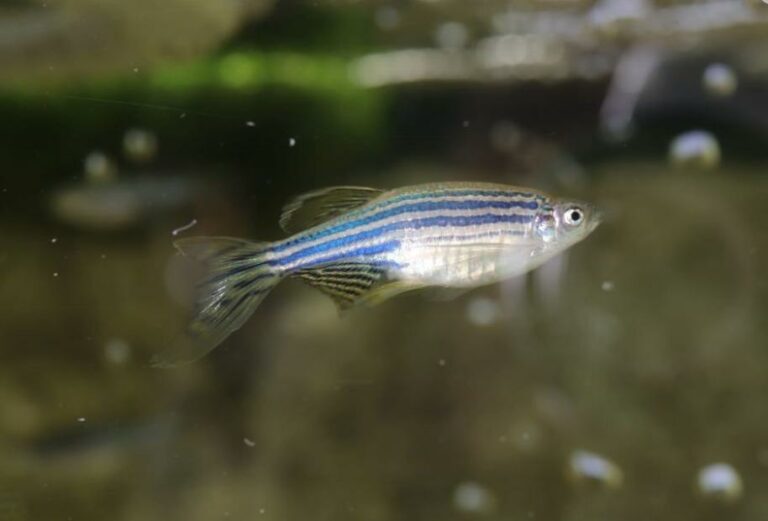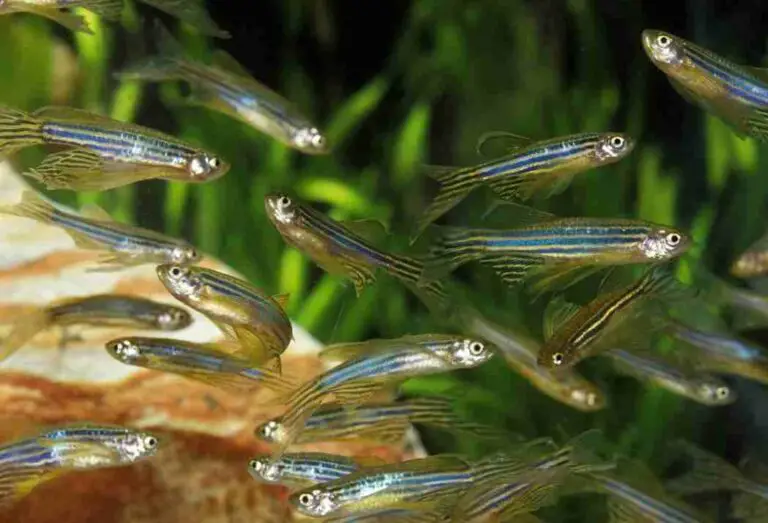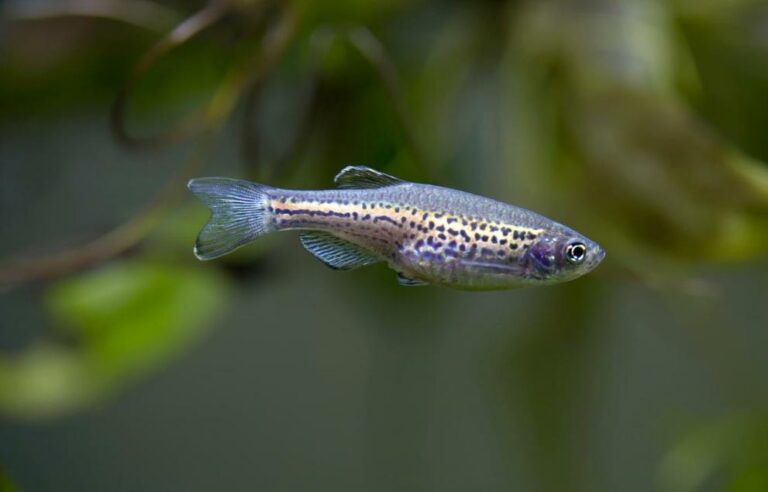Do Zebra Danios Lose Color at Night?
When you keep Zebra Danios in the community fish tank, you will often notice these bright and active Danios lose or fade colors at night. As a fishkeeper, you must be concerned about this matter and find reasons for this case. The Zebra Danios’ magical color transformations are natural from day to night. These small, schooling fish from South America have evolved adaptive camouflage to avoid predators in the wild.
Under moonlight or in darkened aquarium conditions, special pigment cells called chromatophores allow them to radically shift their hues to muted silvers, grays, and browns. This helps conceal their outline during periods of vulnerability.
In the morning, Zebra Danios will reactivate their dazzling daytime colors when the lights come on again in your home aquarium. Healthy Zebra Danios, aged 6-12 months, display the most intense and vibrant palette. Providing optimal water conditions, nutrition, and 6-10 fish school sizes will help maintain their brilliant coloring. Natural live plants also enhance their day/night color changes.
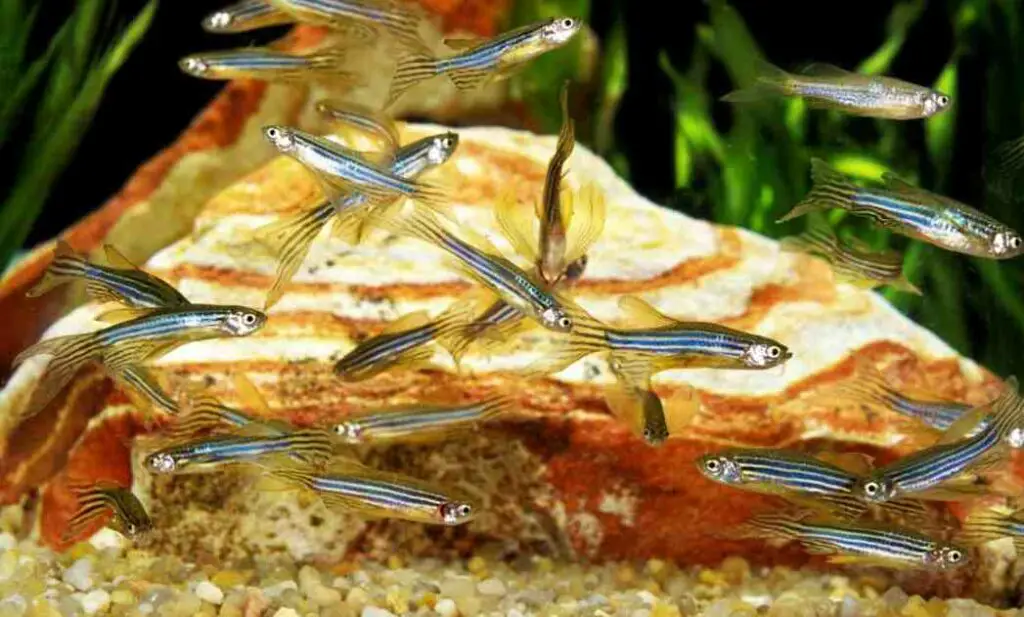
So take a moment after sunset to observe your Zebra Danios transform into their secret nocturnal phase.
Table of Contents
- Why Do Zebra Danios Lose Their Color?
- Do All Zebra Danios Lose Their Color At Night?
- Zebra Danios lighting at night
- Do Zebra Danios Lose Color When Stressed?
- Zebra Danios Genetics cases
- Summary
Why Do Zebra Danios Lose Their Color?
There are many factors why Zebra Danios lose their vibrant colors at night.
Camouflage from Predators
- In the wild, Zebra Danios inhabit densely vegetated areas of streams in South America. Low light conditions make them vulnerable to predators like larger fish at night, so they evolve camouflage coloring to blend into the darkened environment.
- Their chromatophores contain melanin pigments that get dispersed widely across the skin cells at night, making the bright colors disappear and creating mottled brownish hues instead. This helps conceal the Zebra Danios’s outline in darkness.
Protection from UV Rays
- Bright light conditions during the day expose Zebra Danios to more intense UV radiation, which can cause cell and DNA damage.
- At night, the melanin pigments in their chromatophores condense into small spots, reducing the fish’s UV light absorption by up to 64%. This protects tissues from radiation damage in darkness.
Energy Conservation
- Producing and maintaining the Zebra Danios’ vibrant colors during daylight hours requires extra energy expenditure.
- When food sources are scarce at night, the fish conserve energy by dispersing the concentrated pigments in their chromatophores, allowing their colors to fade.
Sexual Selection
- Vibrant red, blue, and green daytime colors help attract mates and facilitate spawning. But at night, camouflage takes priority over sexual display.
- Males may also temporarily lose their bright colors after spawning as their energy reserves get depleted from courtship and fertilization processes. Danio’s color returns when their condition improves.
Providing the Perfect Tank Size for Your Zebra Danios School
www.tinyfishtank.com
Do All Zebra Danios Lose Their Color At Night?
No. Not all Zebra Danios species will lose their vibrant colors at night time. In general, Zebra Danios demonstrate the most dramatic day/night color shifts, while other Zebra Danios species have evolved different forms of nocturnal camouflage, light sensitivity, and pigmentation. Observing each fish’s unique coloring behaviors is part of the fun of keeping Zebra Danios!
Zebra Danios lighting at night
Zebra Danios do not require direct tank lighting at night. Total darkness is most natural for them. In the wild, they inhabit dimly lit streams and forest pools. Moonlight and starlight provide their only nocturnal light. Bright aquarium lights on at night can disrupt their circadian rhythms, stress them, and interfere with crucial hormonal functions.
Aim for a 12-14 hour photoperiod during the day only. Completely turn off tank lights at night or use low-wattage blue lunar lighting if desired. An automatic timer is ideal for maintaining consistent photometric cycles and simulating their natural habitat.
For daytime, a standard fluorescent strip light of around 0.5 to 1 watt per gallon provides a good intensity for Zebra Danios. No unique night lights are needed. Plant growth can be supported with higher-intensity lighting limited to daytime hours only.
By providing Zebra Danios with a dark resting period at night, you can help optimize their health, growth, and coloration while aligning with their natural bio-rhythms. Complete darkness is best.
Do Zebra Danios Lose Color When Stressed?
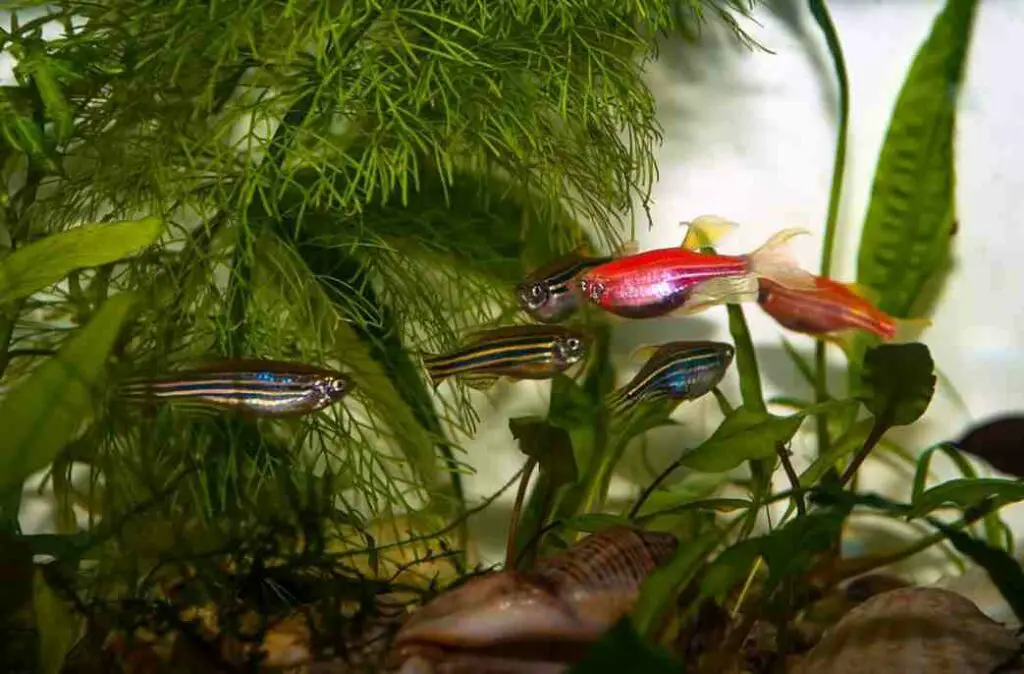
Yes. Stress is a factor that can lead to Zebra Danios losing their bright colors. Improper water conditions like spikes in ammonia, nitrites, wrong pH, and hardness can all trigger a stress response in Zebra Danios. This causes their colors to fade as their bodies divert energy towards coping with the poor environment rather than displaying vibrant hues.
Aggressive tankmates like bettas, cichlids, and angelfish can intimidate and harass Zebra Danios, keeping them in constant anxiety and fear. Chronic stress leads to pale, washed-out colors as they try to stay inconspicuous.
Inadequate schooling numbers can stress Zebra Danios. As schooling fish, they thrive in groups of 6 or more. Solo Zebra Danios or pairs will become withdrawn and lose coloration.
Changes in lighting, water temperature fluctuations, loud noises, and other environmental stressors can also negatively impact their coloring.
The takeaway is to focus on maintaining excellent water quality, compatible tankmates, and an appropriately sized school to prevent stress and allow Zebra Danios to display their most dazzling, healthy colors. Addressing sources of stress helps bring back their vibrant hues.
www.tinyfishtank.com
Zebra Danios Genetics cases
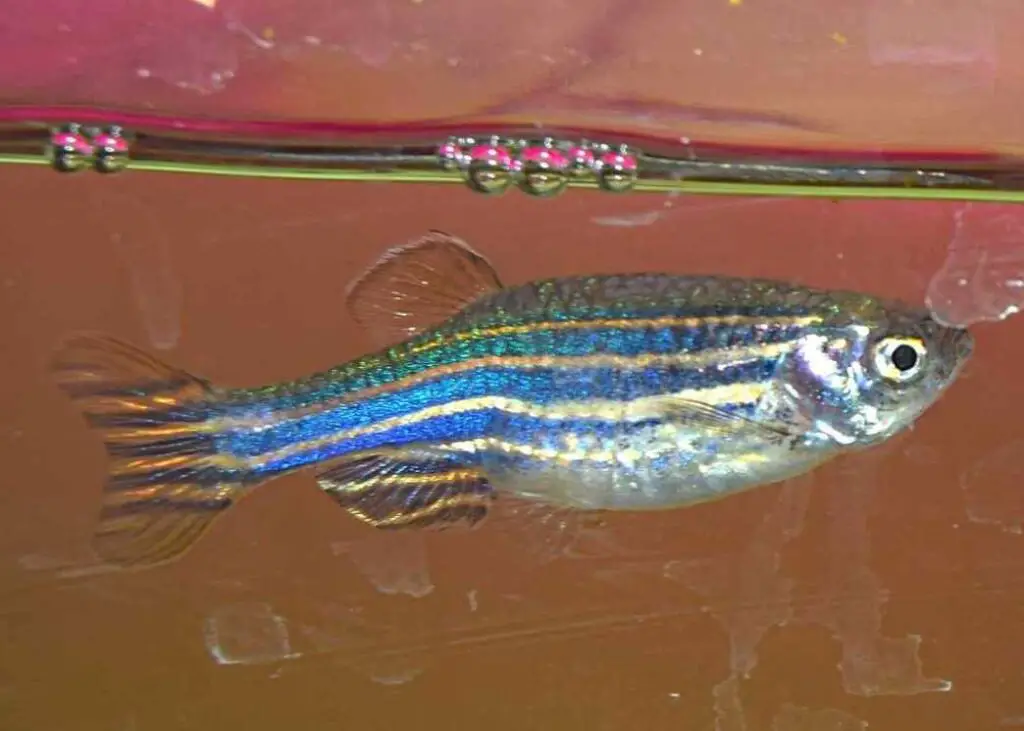
Genetics can play a role in zebra danios losing their coloration. Here are some additional key points about the genetics behind this phenomenon.
- A recessive gene in zebra danios causes a loss of the dark horizontal stripes, resulting in an all-white color morph.
- This genetic mutation affects melanin production, causing melanophore cells to reduce melanin synthesis, which makes the dark stripes disappear.
- The mutation occurs spontaneously in wild populations at low frequencies and is amplified through selective breeding in captive strains. Up to 25% of captive zebra danios may carry the white color gene.
- Both male and female danios can exhibit this mutation, which is seen more commonly in females. The white coloration is permanent once expressed.
- While their vibrant stripes are lost, the health of zebra danios is not impacted. The white strain lives just as long as the wild type.
- The recessive white gene can be passed on to future generations in a predictable ratio by breeding a white danio with a striped danio.
Summary
The vibrant Zebra Danios Zebra Danios is a popular aquarium fish, but owners often notice its colors fade or disappear at night. Rest assured, this transformation is expected.
Zebra Danios have evolved specialized pigment cells called chromatophores that allow them to shift colors from day to night radically. In daylight, their stripes and markings reflect bright blue and green hues. After dark, the chromatophores alter their pigment distribution, creating mottled gray, brown, and silver camouflage coloring to hide from predators.
Their nocturnal hue change protects tissues from UV rays, conserves energy, and facilitates mating behaviors. Not all Zebra Danios exhibit such dramatic day/night shifts. But Zebra Danios require this unique adaptation to their native habitat.
While color loss can also result from stress, healthy Zebra Danios will resume their vibrant palette each morning. Providing excellent water quality, compatible tankmates, proper schools, and a consistent environment will keep your Zebra Danios displaying their most dazzling colors night and day.
Observing the Zebra Danios’ magical color transformations is one of the wonders and rewards of home freshwater aquariums!
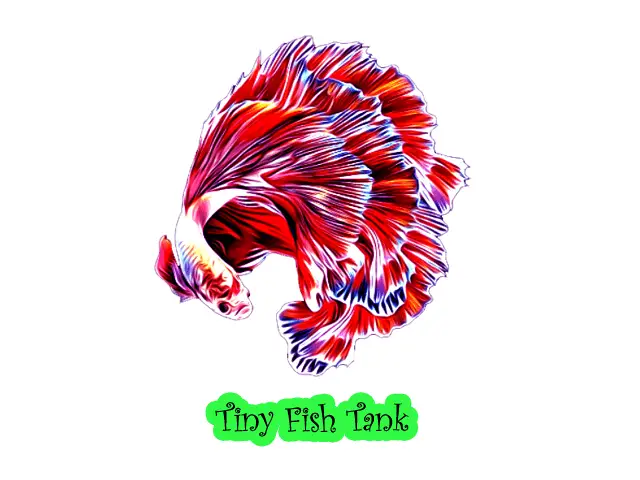
![Why Zebra Danios Jump Out of Tank? [ 5Reasons and Best Solutions]](https://www.tinyfishtank.com/wp-content/uploads/2023/08/Danios-Jump-Out-Tank-768x532.jpg)
